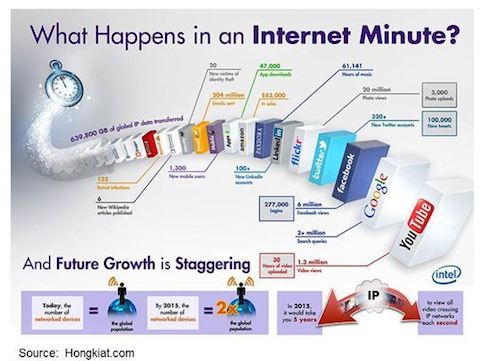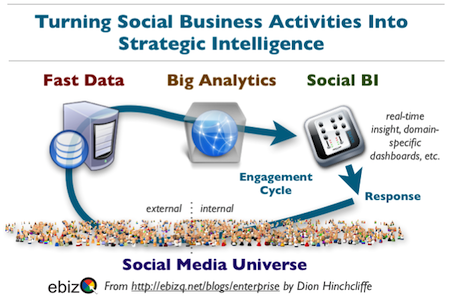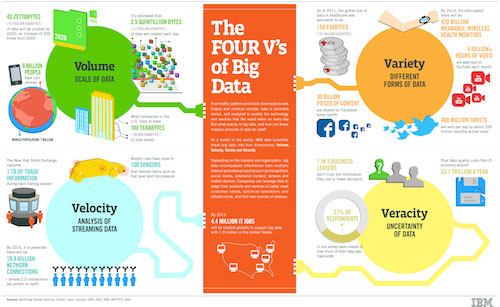By adaptive - August 19th, 2014
Big Data offers endless streams of information. How your corporation locates actionable trends is key to leveraging these vast data stores
In the first part of this series examining the role of Big Data in social media we looked at how it has the potential to transform customer insight. In this second part we are examining the methodologies that corporations can adopt in order to sift through the data and filter out vital content that will deliver commercial opportunities.
When the world is producing around 2.5 exabytes of data a day, pulling out elements of value suddenly make finding a needle in a haystack look strangely simple. However, Big Data is big money as evidenced by investments made by the big social networks such as Twitter who recently acquired Gnip and Facebook’s investing in Presto to gain the insights these businesses need to improve their services.
The business can tap into Big Data and use the information to improve planning, deliver targeted campaigns, fully take advantage of the omni-channel and optimise social media and interactions in real time.
“At the Adobe Summit EMEA this year, Shell’s social lead, Don Bulmer, spoke about how they carry out six months of listening in a market before they begin engaging on social media,” says Marc Blinder, Director, Social and Strategic Marketing at Adobe. “This is a great example of the importance brands are placing on getting a thorough understanding of what is being said about them before acting.”
Shell has over five million fans on Facebook [https://www.facebook.com/Shell] and actively manages around 60-70 micro communities on a regular basis. This demands that they bring in content from parts of the business that are specific to geographies, topical issues or key demographics, like students with youth-based programmes. To do this they have to gain an intimate understanding of their audience and tap extensively into Big Data.
“Big Data means that networks can know their users better than ever and it allows those with knowledge of a user base to target them better by looking at their interests, location and search history,” says Bhavesh Vaghela, CMO of ResponseTap. “Facebook can help a brand up to a point but the completion of that journey must be managed by the organisation themselves – data and insights can track the right person down, but it can’t complete the sale."
The edge
“There is an increasing number of tools available to help businesses more accurately track the data from social media,” says Karine Del Moro, VP Marketing at Confirmit. “As Big Data grows, so does the availability and functionality of the technology available to deal with it.”
Some solutions can undertake a quantitative analysis of social media that includes sentiment, some allow for tracking of social media channels and others are designed to track the effectiveness of campaigns against specific targets. Search terms, key words and brand names can be used to identify the content that references them and these can be further analysed using analytics tools and software.
“Businesses should use social listening tools to capture and analyse huge amounts of data,” says Blinder. “The keyword strategy is the most important element of finding the content that matters to the business. Smart search terms in a listening tool can help surface relevant data about your products and your competitors.”
Some of the data analytics platforms that stand include:
- Apache Hadoop – as used by Facebook and Yahoo and other impressive names in the industry.
- 1010data – popular and based in the cloud.
- Amazon Web Services – this company breathes data so this comes as no surprise.
- Hortonworks Data Platform.
- Pentaho – has the ability to offer a 360 degree view of the consumer using social media
Big Data is a fundamental pillar of Social Business Intelligence, offering up swift and insightful information that can improve customer engagement, business processes and response times across social media and the organisation itself.
According to a 2011 report by the McKinsey Global Institute analysing large sets of data is becoming a key element of competition and is “underpinning new waves of productivity growth, innovation and consumer surplus.” It’s three years later and this fact remains as true today as it did then, if not more so, but the most important consideration isn’t the quantity of data, but the quality.
Not all Big Data is useful. This is one of the most important lessons about Big Data. The tools you use will deliver reams of information, but the value isn’t necessarily the data itself, but rather how it is translated into corporate context. It needs to be extracted and analysed and measured against the business, specific rules and make use of the features inherent within the platforms listed above. Which brings in the next step – have an expert.
There is no need for a person who has extraordinary technology proficiency to run the analytics and translate the data – most of the solutions do the hard work on intuitive platforms already. However, what you do need are people who understand the business and have analytics experience and sit at the level of the C-suite. This blend of data and business proficiency means that the information is filtered and understood accurately within the framework of the organisation. It also ensures that every drop of data is interpreted within a global, corporate and social context.
An expert will also have a measure on the value of time – social media data is now. A national incident, a weather phenomenon, an issue with distribution networks, unhappy customers – this is information that the organisation needs to act on swiftly in order to undertake the necessary action.
“Social media data can help a company take corrective action to retain a high-value group of customers when predictive analysis on the social media data suggests they are at risk to move to a competitor,” says Stuart Wilson, UK Regional Vice President at Alteryx. “Social media data, when aggregated across multiple users, can also help identify trends and prioritise them so brands can take proactive steps to improve the value of their offering.”
In the final part of the series we will be looking at the content the business should be filtering out so they can make the right decisions as well as some of the benefits of using Big Data for Social Business Intelligence.
Image Source: Freedigitalphotos.net
Next Reads
June 2015, New York
With over 50 expert speakers (including 15 CMOs and CCOs) from the world’s most social brands, and 300+ of your corporate peers in attendance, #CSMNY offers unrivaled learning, networking and benchmarking opportunities. It is truly THE social media event of year.
Brochure Programme


